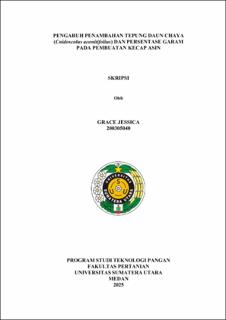Pengaruh Penambahan Tepung Daun Chaya (Cnidoscolus aconitifolius) dan Persentase Garam pada Pembuatan Kecap Asin
The Effect of Adding Chaya Leaf Flour (Cnidoscolus aconitifolius) and Salt Percentage on Salty Soy Sauce Production

Date
2025Author
Jessica, Grace
Advisor(s)
Sinaga, Hotnida
Nurminah, Mimi
Metadata
Show full item recordAbstract
Chaya (Cnidoscolus aconitifolius) or also known as Japanese papaya leaves is a member of the Euphorbiaceae family. Chaya has the potential as an alternative raw material substitute in the manufacture of soy sauce because it contains protein and active compound components in the form of tannins, flavonoids, alkaloids, saponins, cyanogenic glycosides, and vitamin C. Soy sauce is a processed liquid product made from fermented soybeans. Salty soy sauce is also a fermented soybean product with the addition of a high percentage of salt. Moromi fermentation with a high percentage of salt in the manufacture of soy sauce will involve the role of Lactic Acid Bacteria (LAB) to hydrolyze soybeans. The aim of this research was to determine the effect of adding chaya leaf flour, salt percentage, and the interaction of adding chaya leaf flour and salt percentage on salty soy sauce production. This research design were Factorial Completely Randomized Design (CRD) with two factors: the addition of chaya leaf flour (T) : (0%; 5%; 10%; and 15%) and salt percentage (G) : (20%; 23%; and 26%). The research parameters analyzed were protein content, vitamin C content, acidity level (pH), ash content, NaCl content, total flavonoids, color index, viscosity, and hedonic values of color, taste, aroma, viscosity, and general appearance.
The results indicated that the addition of chaya leaf flour (T) significantly affected (P<0,01) the protein content of moromi, protein content of salty soy sauce, vitamin C content of salty soy sauce, ash content of salty soy sauce, color index of salty soy sauce, total dissolved solids of salty soy sauce, viscosity of salty soy sauce, total flavonoid content of salty soy sauce, hedonic taste of salty soy sauce, and overall acceptance of salty soy sauce. The percentage of salt (G) significantly affected (P<0,01) the protein content of moromi, acidity index (pH) of moromi, protein content of salty soy sauce, acidity index (pH) of salty soy sauce, ash content of salty soy sauce, NaCl content in salty soy sauce, total dissolved solids of salty soy sauce, viscosity of salty soy sauce, hedonic taste of salty soy sauce, and overall acceptance of salty soy sauce. The best treatment was determined based on the De Garmo method was T3G2, which were the treatment with a 10% addition of chaya leaf flour and 23% salt percentage.
Collections
- Undergraduate Theses [636]
